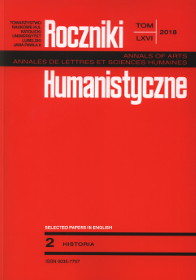Sodalities of our Lady Existing in Kraków Secondary Schools in the 19th Century and in the Second Polish Republic
Sodalities of our Lady Existing in Kraków Secondary Schools in the 19th Century and in the Second Polish Republic
Author(s): Alicja PuszkaSubject(s): History, Modern Age, 19th Century
Published by: Towarzystwo Naukowe KUL & Katolicki Uniwersytet Lubelski Jana Pawła II
Keywords: odality of Our Lady; Jesuits; education of the youth; cult of Our Lady
Summary/Abstract: The Polish version of the article was published in Roczniki Humanistyczne vol. 57, issue 2 (2009). The Sodality of Our Lady is a Catholic religious association for young people founded in the Jesuit College in Rome in 1563 by Fr Jan Leunis. The most gifted and devout boys joined the Sodality in order to spread the cult of the Mother of God. Popes provided care for the vibrantly developing movement because of the great influence Sodalities of Our Lady had on the religious formation of young people. Jesuits established Marian congregations of students attending colleges in all Catholic countries, forming an international elite organization of lay Catholics. Sodalities thrived and they spread to all social estates in the 17th and the first half of the 18th century. Not only did school students belong to it, but also popes, kings, the gentry, clergy, townsfolk, craftsmen, military men and servants. The chief objective of the Sodality was to live by the motto “Per Mariam ad Jesum.” The development of the Sodality was halted by the dissolution of the Jesuit Order. In the middle of the 19th century the pronouncement of the dogma of the Immaculate Conception of the Holy Virgin, made by Pope Pious IX, opened a new era of the cult and a new period in the history of the Sodality.In Poland, the first Marian congregation of school students was established in Braniewo in 1571. At the end of the 18th century, before the dissolution of the Jesuit Order, in Poland there were 66 colleges, seminaries and monastery schools, and there was always at least one congregation affiliated to each of the schools. At the end of the 19th century, school sodalities were revived in Galicia, i.e. in Tarnopol, Chyrów, Tarnów, and in a girls’ secondary school run by the Ursulines in Kraków. A dynamic development of Marian congregations of school students started after Poland regained independence in 1918. The centre of the sodalitarian movement for all the estates was Kraków. The movement gained solid foundations in the two powerful sodality unions of both secondary school boys and girls. Father Józef Winkowski established a sodality for boys, and Fr Józef Chrząszcz one for girls. Sodalities published their own magazines, organized conventions, pilgrimages to Jasna Góra (Częstochowa, Poland), and ran charity organizations. In the late 1930s, nearly seventeen thousand students of secondary schools throughout the country were members of school sodalities. At the dawn of the Second Polish Republic, the greatest number of school sodalities operated in Kraków. There were 11 boys’ sodalities in secondary state schools and one in a private school run by the Piarist Order, and 11 girls’ sodalities in state and private schools. The Sodality of Our Lady contributed to the religious revival in Poland. The development of this organization was halted by World War II. After the war, in the years 1945–1949, the operation of the Sodality of Our Lady was resumed in many centres. The liquidation of church organizations in 1949 stopped its work for good, and its members came to be persecuted by the Communist regime.
Journal: Roczniki Humanistyczne
- Issue Year: 66/2018
- Issue No: 2SP
- Page Range: 119-136
- Page Count: 38
- Language: English

